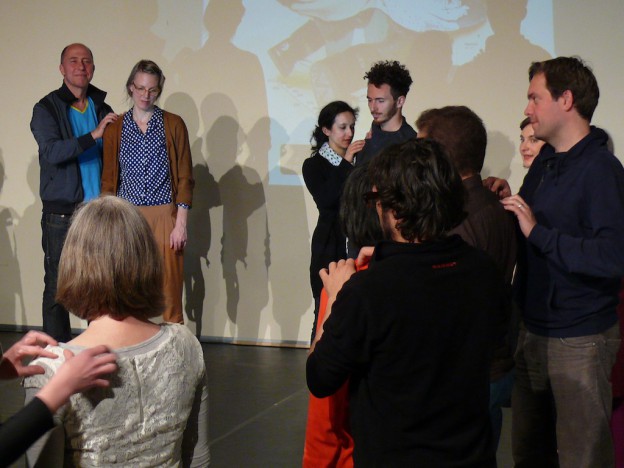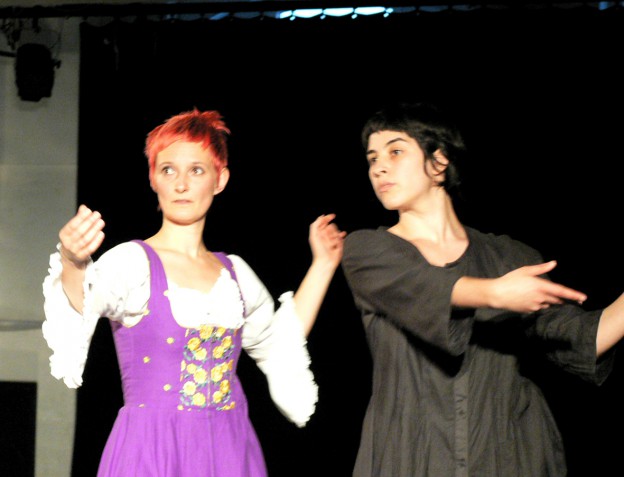19.07.2012Performing Improvisation with Ray Chung, Katarina Eriksson, Gabriele Reuter. Tanzfabrik Berlin
Tag:Improvisation
Susi & Gabi’s Salon #9 Ein Abtakt – TanzHochZwei Festival
Die Körper der letzten Tage – Ein Abtakt 15.04.2012 at Tanzfabrik BerlinSalon Guests: Vincent Bozek und Sophie Jahnke A second evening on transforming body and shifting dance practices. This time Susi and Gabi throw themselves and their own current practice of improvisation on the stage working on recipes from two weeks workshops, rehearsals, lectures and… Continue reading Susi & Gabi’s Salon #9 Ein Abtakt – TanzHochZwei Festival
Susi & Gabi’s Salon #8 Ein Auftakt – Tanz Hoch Zwei Festival
“Die Körper des Tages – Ein Auftakt” 31.03.2012 at Tanzfabrik BerlinSalon Gäste: Dieter Baumann, Shannon Cooney, Christa Flaig, Marion Glöggler, Kirstin Heinrich, Jutta Hell, Sophie Jahnke, Gisela Müller, Ludger Orlok, Britta Pudelko, AnnA Stein This salon invites teachers of this year‘s workshop program and the Tanzfabrik team to devote their improvisations to the topic of… Continue reading Susi & Gabi’s Salon #8 Ein Auftakt – Tanz Hoch Zwei Festival
Susi & Gabi’s Salon #7 Plymouth
Salon Guest: Adam Benjamin29.11.2011 at Plymouth University After four editions in Berlin with such wonderful guests as Amos Hetz (Jerusalem), Andreas Mueller (Berlin), Rosalind Crisp (Paris) and Hodworks (Budapest), Susi‘s and Gabi’s Salon resides this autumn in Leicester and Plymouth, meeting improvisation based artists from the UK and the famously playful and witty British audience.
Susi & Gabi’s Salon #4 The A-word: Ageing 2011
Salon Guest: Amos Hetz04.09.2011 at Tanzfabrik Berlin Amos Hetz is a dancer and movement teacher, looking for expanding his movement vocabulary through the use of the Eshkol Wachman Movement Notation and the heritage of the somatic learning. He composes solo dances, dance-collaborations, and movement games. For the last 22 years he was artistic director of… Continue reading Susi & Gabi’s Salon #4 The A-word: Ageing 2011
Susi & Gabi’s Salon #3 Berlin
100 Fragen an die Improvisation Salon Guests: Joris Camelin, Rosalind Crisp, Luc Dunberry & Mata Sakka.10.07. 2011 at Tanzfabrik Berlin
Susi & Gabi’s Salon #2 Berlin
100 Fragen an die Improvisation Salon Guest: Andreas Albert Müller04.06.2011, Tanzfabrik Berlin In der zweiten Ausgabe ist Andreas Albert Müller aus Berlin zu Gast, den wir gebeten haben, etwas von seiner Auseinandersetzung mit Rosalind Crisps choreographischen Methoden vorzustellen.Tanzen aktualisiert sich dauernd durch tanzendes Befragen, Denken und Tanzen laufen ineinander. Das Bewegen spannt sich auf zwischen… Continue reading Susi & Gabi’s Salon #2 Berlin
Susi & Gabi’s Salon #1 Berlin
100 Fragen an die Improvisation Salon Guests: Hodworks (Budapest): Emese Cuhorka, Júlia Garai, Júlia Hadi, Adrienn Hód, Csaba Molnàr08.05.2011, Tanzfabrik Berlin Ein Salon in dem sich Gabriele Reuter und Susanne Martin auf verschiedenen Pfaden dem Phänomen der Improvisation widmen: praktisch, tänzerisch, theoretisch, mit Zuschauerbeteiligung oder mit geladenen Gästen. „Wir verstehen unsere 3 Ausgaben bis zum… Continue reading Susi & Gabi’s Salon #1 Berlin
GIF – Granada Improvisation Festival 2010
Organized by Mamen Agüera Pérez With Veronica Garcon Toldos; Kateřina Dietzová; Eckhard Müller; Mamen Agüera Pérez and others.Thanks to Mamen and the unknown photographer!!
Performing Improvisation – Freistil Spezial
Tanz Hoch Zwei Festival 04.04.2010 at Tanzfabrik BerlinTrio with Julieta Figueras, Gabriele Reuter; duet with Valeria Primost
What’s my teaching about … in 2011
My teaching today derives from my experience and ongoing practice as performer and performance maker, and my own ongoing training in dance and improvisation. Apart from this it is influenced by my education as dance teacher which I gained at Rotterdam Dance Academy (today called Codoarts) and the two year process of completing my masters… Continue reading What’s my teaching about … in 2011
Rosi bei Freistil – Die Kunst der Improvisation (2008/2009)
„Material zu Rosi tanzt Rosi“ Eine Soloimprovisation Freistil at Tanzfabrik Berlin 6. 4. 2008 Was macht Tanz lesbar für die Zuschauer?Was ist der Text eines Tanzes?Wie erhalte ich meine Freiheit in der Improvisation, wenn ich mit klaren thematischen Grenzen und Narration arbeite? “Neuigkeiten aus der Rosi-Welt“ eine Improvisation von Susanne Martin Freistil at Tanzfabrik Berlin… Continue reading Rosi bei Freistil – Die Kunst der Improvisation (2008/2009)





